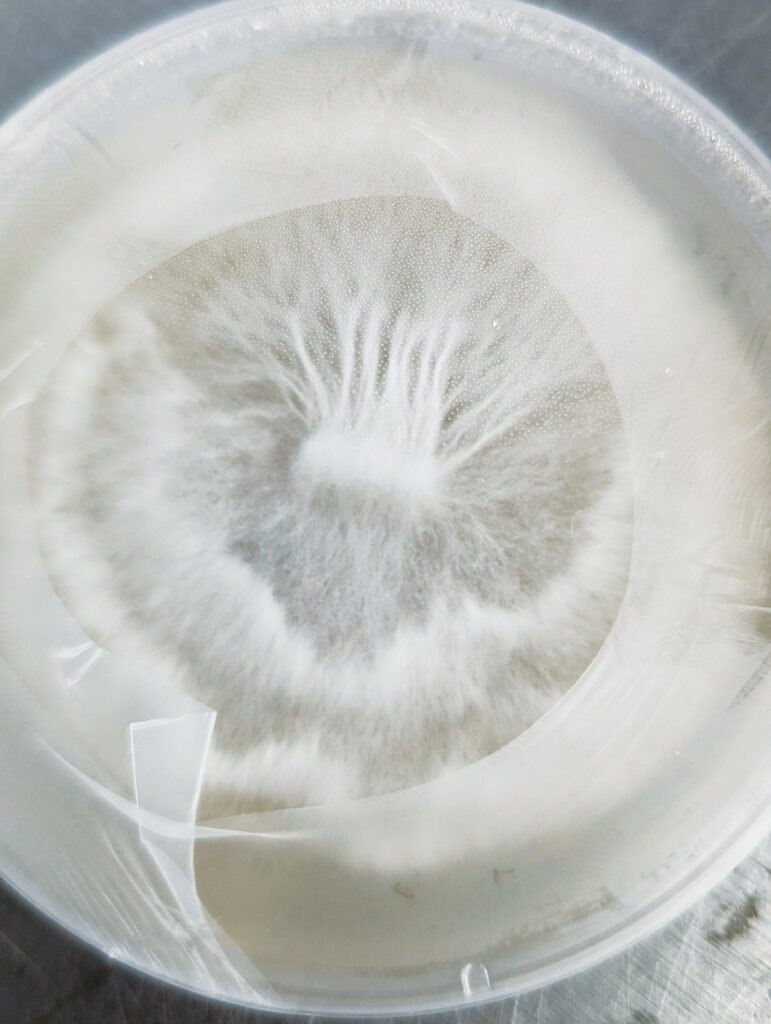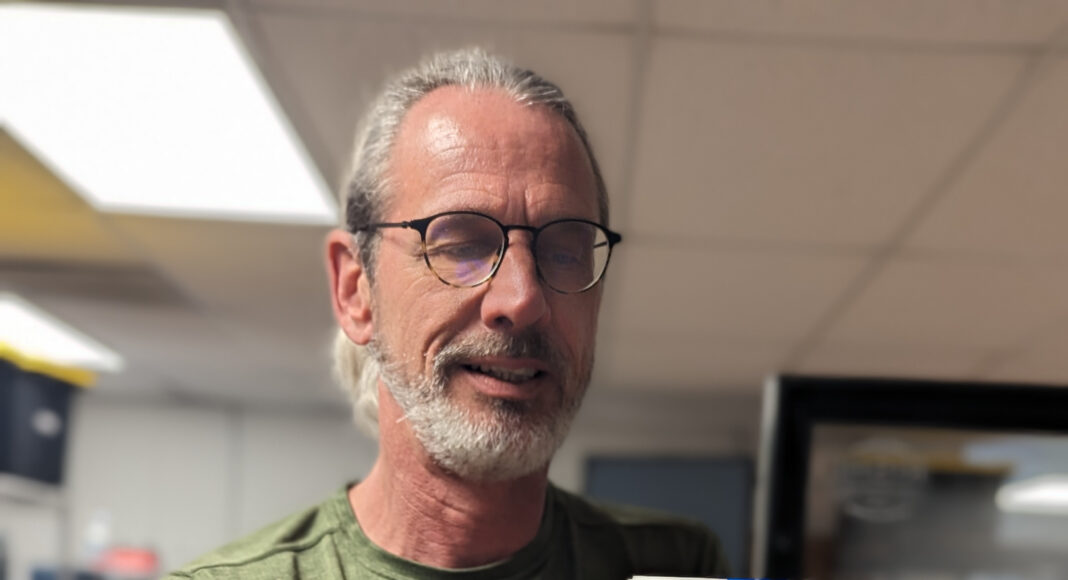Maybe you’ve heard: A mutated form of parasitic mushrooms called cordyceps is converting billions of humans into hyper-scary, hyper-athletic and hyper-contagious zombies.
They’re rampaging across the planet, devouring faces and spewing infectious spores.
That’s the fiction at the heart of The Last of Us, a smash hit series on HBO, which is built on scientific fact and then layered with creative liberties and a mass-panic apocalypse.
IRL, cordyceps actually do invade insect hosts after a spore lands on them and deploys its mycelia tendrils. Once the bug is paralyzed or dead, the fungus erupts out of the insect with a fruiting body (what most know as a mushroom), spreading its spores to other insects of the same species.
Like the show’s heroes, Joel and Ellie, Watsonville-based chef Dory Ford is one step ahead of the mushroom zombies, which keeps with a theme.
When he captained Monterey Bay Aquarium’s kitchens, he was ahead of the curve on smart and local sourcing before sustainability was a buzzword. When he moved on to school projects, he helped reinvent student nutrition. When he launched a catering juggernaut called Aqua Terra Culinary, he refined—and even redefined—how organic food, chic clients and limited food waste could harmonize.
Before millions of HBO viewers started Googling “cordyceps,” he was well into a fund-raising campaign to begin cultivating them while plunging into mycelium science lessons from other species (hence the name of his new farm-laboratory, MycoSci).

Ford laughs when he first learns that the mushroom he’s focused on became the demon protagonist of a deliriously popular show inspired by a video game.
“Yeah, we like to get ahead of the game,” he says.
MUSHROOM REVELATIONS
Mushrooms like the dark. So maybe this saga should start in a dark place.
When COVID brought its own sort of apocalypse, Ford was forced to close his restaurant and catering operation. The professional passion of his last three and a half decades went poof. It would be fair to say he fell into a zombie-like state.
“My entire business model—my entire life’s work—disappeared,” he says. “I was not well. What was I gonna do? I can’t sit at home and watch Netflix. I have ADHD; my leg bounces up and down.”
A psychedelic savior came into the picture organically. A loved one told Ford about 1) her hope to get off prescription antidepressants and 2) her curiosity in psilocybin-based treatments, i.e., the increasingly widespread (and increasingly legal) use of so-called magic mushrooms to relieve everything from anorexia nervosa to post-traumatic stress.
He offered to help and, after some successful therapeutic doses, went looking for more medicine.
COVID-related supply chain chaos, however, meant there was no psilocybin to be found easily. Ford ordered a grow box online and began experimenting with cultivation for personal use.
He deflects any notion of a “lightbulb moment”; instead, he simply applies his problem-solving skills. Still, that led to some lightbulb-like revelations.
“As a chef, you spend years dealing with something caught, killed, picked or cut,” he says. “By the time you get something, it’s at the end of its lifespan.”
His new task presented a different paradigm.
“When you get involved from a farming perspective, you’re creating life,” he says. “The instructions are a little different. You watch something grow, and you give them reverence.
“There’s enlightenment that came with that for me: ‘I’m OK with things.’ ‘I’m not going to crawl out of my skin.’ It allows you to carry on, to touch base with like-minded people, to find out you’re not alone.”
CORDYCEPS CHARM
Mycelium author, researcher, entrepreneur and author Paul Stamets likes to talk about how mushrooms can rescue the planet, which sounds hyperbolic but might be an undersell.
He writes and talks about how mycelium can decompose toxic and biological waste and prevent pests like ants and termites from destroying homes and crops. (Stamets has eight patents to prove it.)
He spotlights how it can convert cellulose into usable fuel and how it filters pathogens from polluted streams. He notes how it resists bacteria, which is why many antibiotics can be found in mushrooms. He observes how it can repair habitat post-natural disasters, perhaps on a Last of Us level.
His TED Talk on life-saving mycelium mojo has more than 8.6 million views. The 17-minute talk is fast-moving and fascinating and merits viewing for Good Times readers—as does the spellbinding 2019 Fantastic Fungi: The Magic Beneath Us documentary he stars in. Both videos deserve a spot in soil science curriculums everywhere.
“I love a challenge,” he says to start the TED Talk, “and saving the Earth is probably a good one.”
Last week, another TED Talk, “Could fungi actually be the key to humanity’s survival?” circulated on TED Recommends mailing lists.
“Maybe for the future, if we can learn from fungi,” says mushroom researcher and restaurateur David Andrew Quist, “we might be able to transform ourselves and our society in ways that are in greater harmony with nature.”

The short answer, for Ford is, Hell yes, we can.
One way to get there is by way of taste buds and tummies. So far, this look at shroom superpowers doesn’t include their flavor flex. It’s a pause to salute all the healthy, tasty and umami-rich elements available from enoki and oyster, morel and maitake, shiitake and porcini and cremini. But not much is known about cordyceps’ taste profile, at least among most Americans.
That was a theme when Ford hosted his first public tasting event in three years at Elroy’s Fine Foods in Monterey last week, which featured live mushroom packs of cordyceps. According to Ford, some of the most common reactions are: “What is that?” “Can I touch it?” and “That’s delicious!”
“People left surprised and intrigued,” he adds.
The last reaction tracks back to the flavor front: What he prepared reflects cordyceps’ versatility and depth. (As do dishes from MycoSci partner chef Colin Moody, who’s crafted everything from cordyceps arancini to cordyceps maple ice cream with cordyceps streusel.)
On April 28, Ford sautéed the cordys for 30 seconds, then laid the brilliant orange against a soba noodle salad background of seasonal greens like kale, snap peas, asparagus, baby zucchini, green beans and scallions with a bit of radish, sweet corn for balance and a miso dressing—spiked with cordyceps powder.
“It does really well with all those Asian-leaning notes,” he says.
That makes sense: As opposed to most Westerners, traditional Chinese medicine practitioners—and eaters—know cordyceps well, partly because the fungi hail from the high mountains of China, where they grow wild on caterpillars. (MycoSci raises them on a proprietary—and sterilized—silkworm larvae substrate.)
Their historic applications include combating kidney disease, fatigue and dipping sex drive. Some studies have shown that they offer antioxidants, slow tumors, aid people with type 2 diabetes, soften the effects of arrhythmia heart conditions and slow down inflammation.
In my test run with MycoSci’s debut product—convenient snack packs of seasoned cordyceps—I felt more energized for an afternoon workout—anecdotal evidence, yes, but an experience that syncs with reports that cordyceps improve blood flow.
Interestingly, the U.S. Department of Veteran Affairs has solid knowledge of the mushroom. It describes a range of specifics on its portal for holistic, alternative and medicinal methods (aka Whole Health).
“It is sometimes considered an adaptogen due to its immune-boosting properties … ” Whole Health reports. “Small studies have shown and can be beneficial in … renal damage for improving quality of life and cellular immunity after chemotherapy treatment, and for supporting liver function for those with hepatitis B.”
Cordyceps possess other charms. To start, they’re not a Schedule I controlled substance by the federal government (as is psilocybin). MycoSci stands ready to pivot at least in part toward medicinal psychedelics if and when regulations change— “When they catch up,” as Ford says—but for now, it’s the little-mushroom-that-could they’re focused on.
More good news: Cordyceps are relatively easy to grow and fetch a premium price of over $25/pound. The quality of what MycoSci is producing proves impressive enough that, pending negotiations, Far West Fungi is open to buying their entire supply.
The little Cheeto-looking fungi also catch the eye, which helps their visibility at independent grocers where MycoSci mushrooms are increasingly available.
In addition to Elroy’s, they appear at Far West’s spots in Santa Cruz, the San Francisco Ferry Building and Rainbow Grocery Cooperative in S.F. In MycoSci, Far West CEO Ian Garrone finds a fitting partner for what his family business wants to do.
“We’re always trying to bring in local, sustainable agriculture, especially with mushrooms, and not a lot of people are doing cordyceps,” he says, noting he sells 100 pounds a week, previously all from China. “It allows us to support local, provide more niche organic artisan mushrooms, get oxygen in your system—and it has great flavor, a little sweetness, something you can use in food and as a potent medicinal.”
MyoSci FUTURE
MycoSci’s one full-time employee is grow director Michael Bandy, who studied ecology and evolution at UCSC. He then started cultivating mushrooms in his basement before developing a full-send fungi farm in a 4,500-square-foot facility.
His main charge currently: scaling the cordyceps cultivation effort by tweaking light levels, substrate amounts and more. He’s looking at what he calls “a wide spectrum of potential nutrient ingredients,” all vegan—think nutritional yeast, spirulina and kelp, among many others.
The plan sounds good overall: working on optimizing life force with mindfulness.
“Operating and processing as efficiently as possible,” he says.
He’s audibly stoked by the challenge and is excited to apply his experience in extractions, tinctures and cultivation, using fancy tools like rotary evaporators and high-precision liquid chromatography-mass spectrometry usually reserved for the likes of pharmaceutical and forensic laboratories.
But as much as anything, he sounds most eager about advancing understanding of a range of shroom species, which gets at the big-picture thoughts running through the mycelium minds of Stamets and Ford.

Bandy articulates a vision of elevating the food and supplement industry in the United States by using science to inform growing and extraction practices and product development, which sounds cutting edge but isn’t exactly. That was how many food systems worked before yield and timing took precedence over nutrition and quality.
“With our analytical tools, we can learn to grow our mushrooms in a way that will maximize beneficial compounds and nutritional density,” he says. “This is not new technology. It can—and should—be applied to our entire ag system.”
Put differently: Sleep peacefully, free of zombie-stalked nightmares, knowing the mushrooms will not create the next apocalypse.
It’s the mushrooms that will prevent it.
More at mycosci.com. The cordyceps-soba noodle-salad recipe is available at instagram.com/myco.sci















Fascinating ~~ Nutritious plus I believe in psilocybin for “re-flowering” my brain dendrites and synapses. Thank you…